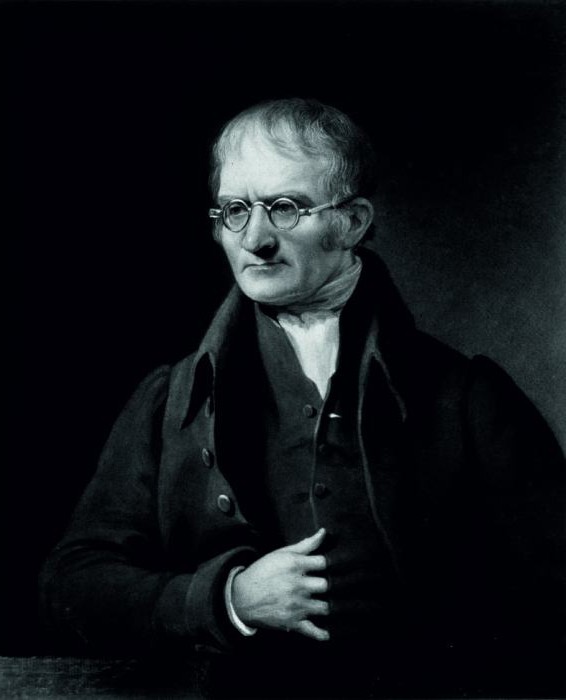Defining only one scientific specialty to which John Dalton can be assigned is difficult. One of the most respected and honored scientists of his time was a physicist, chemist, meteorologist.
Known for his work on the English language. He was the first to investigate the color vision defect that he possessed and which was later named after him - color blindness.
Self-taught teacher
The universalism of his scientific aspirations and the variety of research interests can be partially explained by his lack of a systematic education in a specific field. John Dalton was born on September 6, 1766 in the town of Eaglesfield, in the county of Kimberland in northern England, in a poor weaver's family. His parents were dissident Quakers, who denied anything connected with the official Anglican church, so it was impossible for John to attend educational institutions.
The need to earn money from an early age, high abilities and the desire to acquire knowledge led to an unexpected result. Thanks to his acquaintance with John Gough, a blind scholarly philosopher, who transferred part of his knowledge to him and stubborn self-education, John Dalton began working as a teacher in a rural school from the age of 12.
Dalton meteorologist
Dalton's first publication was a work called Meteorological Observations and Experiments (1793). Thanks to her, he met with scientists who helped the young teacher move to Manchester and get a job as a math teacher at New College. He became interested in meteorology due to his acquaintance with Elih Robinson, a scientist and engineer from his hometown of Eaglesfield. John Dalton in his work, containing many ideas that led him to the future discovery of gas laws, developed the theory of atmospheric flow formation proposed by George Headley.

In 1787, the scientist began to keep a diary of meteorological observations. John Dalton, whose biography is very interesting and instructive, made the last entry in his diary with a weakening hand after 57 years. These records were the result of studying the composition of atmospheric air - Dalton's most significant achievements in chemistry and physics. One of the first he began to measure air temperature at different heights, making regular trips to the mountains in the Lake District in the north-west of the country.
Color blindness
The second major work of the scientist was devoted to philology - “Features of English grammar” (published in 1801), but then his attention was attracted by his own peculiarity of vision associated with color perception. After living for about 35 years, he discovered that he perceives colors differently than most people, and that his brother has the same peculiarity. Quickly understanding that it was not only a matter of classifying shades (the color he called blue was different from what the others thought it was), Dalton expressed his thoughts on the causes of this phenomenon.

The conclusion about the hereditary nature of such a visual defect was correct, but the explanation for its discoloration of the eye fluid was subsequently refuted. The thoroughness of the research and the originality of the approach to the problem, which were shown to scientists in the article “Unusual cases of color perception” (1794), led to the appearance of the term color blindness, which has been used by ophthalmologists since then.
Gas theory
The ability to draw conclusions from observations and experiments, leading into related fields of science - the basis of the creative method, which was perfectly mastered by John Dalton. Discoveries in chemistry and physics made by him are often based on the same experiments. From studying the composition of the atmosphere, the streams that form the weather, he went on to study the interactions of gases depending on their physical and chemical properties - density, pressure, etc. The results of these works allowed him to make discoveries in the corpuscular - atomic - nature of matter.
Experiments with gases led Dalton to the discovery of several fundamental laws: the partial (inherent in individual components) pressures of the gas mixture (1801), the law of thermal expansion of gases (1802), and the laws of gas dissolution in liquids (1803). The conclusion about the difference in the magnitude of the atoms constituting the gases and the presence of a near-atomic thermal shell allowed Dalton to explain the nature of the expansion of gases upon heating, their diffusion, and the dependence of pressure on external conditions.
Dalton Atomics
The idea that everything in nature consists of the smallest indivisible elements was expressed by ancient authors. But it was Dalton who gave these ideas materiality. The main provisions of his theory were several statements:
- All material objects consist of the smallest - indivisible, created only once particles - atoms.
- Atoms of one substance are identical in mass and size.
- Atoms of different elements differ in size and weight.
- More complex particles of matter consist of a certain number of atoms of various kinds.
- The mass of complex particles of a substance is equal to the sum of the masses of their constituent atoms.
The model of the molecule made by Dalton from wooden balls is carefully preserved. The most important merit of the scientist is the introduction into scientific practice of the concept of relative atomic weight, the definition of the hydrogen atom as a unit of molecular weight. Atomic mass became basic substance in a quantitative characteristic chemistry. Not all Dalton’s ideas about the atomic structure of matter were correct due to the underdevelopment of general physics, but his theory served as a powerful impetus in the knowledge of the atom.
Confession
Few people have reached the heights in science, having such a complex beginning as John Dalton. A brief biography of the scientist is a vivid example of how determination and thirst for knowledge change a person’s life. It allows you to trace the path of becoming a strong personality and see how the boy, who has no chance of getting a serious systemic education, was transformed, to whom his parental beliefs blocked his path to the university, into an internationally recognized scientist, a member of the most prestigious scientific academies in Europe.
There are few examples in the history of such a devoted, almost monastic service to science, which was conducted by John Dalton. Photos of portraits written from a scientist in the final period of his life show a man who devoted all his strength to methodical and intense work.
The reward for Dalton was the recognition of colleagues and students. The statue of the scientist was installed at the entrance to the Royal College of Manchester, where he taught during his lifetime. In the future, this recognition grew into real world fame.